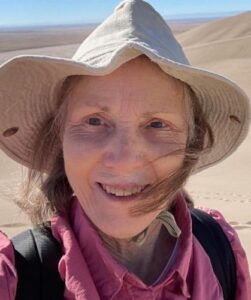Long-time member of the Washington Conservation Guild, Ann Hitchcock, passed away December 10, 2024 at the age of 78. An obituary (below) was published in The Washington Post on December 20, 2024. Hitchcock was a pioneering figure in the field and was instrumental in establishing a system to catalog National Parks Service collections. She was a strong ally of conservators and conservation across the world.

Ann Hitchcock, who was the first Chief Curator of the National Park Service, and early in her position was the highest ranking non-political woman employee in the Park Service, died December 10, 2024; she was 78.
Ms. Hitchcock joined the Park Service in 1980 in the newly-created position of Chief Curator, joining the ranks of the Chief Historian, Chief Archaeologist, and Chief Historical Architect. Her role was to lead improvement in the management of collections of objects and archives held by the NPS in the nearly four hundred park and monument sites across the country. Previously, historic objects valuable to the mission of the NPS were often inconsistently secured, catalogued, and curated, sometimes in circumstances that did not meet museum standards of preservation and protection. There were thought to be about ten million objects in NPS holdings — guns and cannons from battlefields, the decorations and furniture in Presidential homes (including the White House), Native American ceramics and ceremonial garments collected in parks, and objects and archives associated with the mission of specific park sites from locomotives at Steamtown NHS to Edison’s experiments in his New Jersey laboratory.
From 1980 till 2007, Ms Hitchcock oversaw the development of a first-class curatorial and collection management system, with well-funded expansion of cataloguing efforts, including computerized cataloguing, pushing for facilities in park sites for proper storage and research access of museum material, and professional development of curators of varying credentials in the parks; one tool was the publication of “Conserv-o-Grams” that would promulgate tips and modern methods of preservation and conservation of objects needing specialized treatment to park staff who might lack up-to-date expertise in handling specialized natural history or cultural history objects, like animal skins, Indian array, or the gown of a presidential wife. Her role included visiting and reviewing curatorial activity in the majority of the park sites in the country. As usual in museums, many objects would be on exhibit — typically in Visitors’ Centers — but the higher percentage would be in controlled and safe storage with access for scholars. Under Hitchcock’s leadership and management, the NPS found that by internal searching, acquiring, and cataloguing, its holdings expanded from an estimated 10 million objects and archives to well-over 125 million cultural objects, natural resource specimens, and archives, making it the second largest museum collection in the world after the Smithsonian. The NPS program thereafter became the model for the Department of the Interior-wide museum program, which Hitchcock helped establish.
In 2007, Hitchcock transitioned from the position of Chief Curator to become a Senior Advisor for Scientific Collections and Environmental safeguards, where she led service-wide initiatives that involved new authorities and policy for regulating technology transfer, the details of permitted scientific collecting, management of living collections (especially microorganisms), and safeguards for cultural and natural resources. One notable multi-year effort involved creation of policies for “benefit-sharing” when materials collected by outside researchers, or employee inventions, might have commercial application; the model developed has been of considerable interest from other countries faced with exploitable resources.
In addition, Ms. Hitchcock — building upon her wide acquaintance with the experts in conservation and preservation throughout the NPS system — became the principal “recruiter and deployer” of NPS and Interior Department personnel into natural disaster situations, like hurricanes, where there were needs for assessment and restoration. In her Senior Advisor role she continued her career as an important “institutional memory” for the Park Service. At the time of her death she was still employed, with 44 years of Federal service.
Frances Ann Hitchcock was born September 6, 1946, in San Francisco, and grew up in Oakland, California. She graduated from Stanford University in 1968 and completed a Master’s degree in Anthropology and Museum Studies from the University of Arizona in 1970; immediately thereafter she participated in archaeological digs in Arizona and Israel. Before joining the Park Service, she worked at the Museum of Northern Arizona in Flagstaff, and spent four years as the Assistant Chief Curator at the Museum of Man and Nature in Winnipeg, Manitoba, Canada. She had academic appointments, honors, and many publications and conference presentations during her career. She loved the outdoors and the National Parks from adolescence, and recreationally she maintained an intimate relationship with parklands, hiking, canoeing, and backpacking in remote areas, and cross-country skiing. Her friendships and collegial relationships reflected these passions and were life- and career-long. Her marriage to Christopher N. Brown ended in divorce, and she was subsequently married to Richard R. Palmer for thirty-four years, who survives her. She is also survived by two step-children, Mari Carroll Palmer McDonald, and Michael Roy Jarvis Palmer; and four grandchildren, Margaret Penelope McDonald and Meadow Catherine Virginia McDonald, and Alice Rita Palmer-Brown and Edward Fox Palmer-Brown. There will no local funeral or services. J. Gawlers Sons are handling arrangements. At a later time a suitable Memorial Service will be held in Washington, DC to celebrate her life and career; this event will be timely announced.